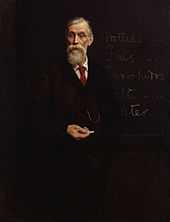Michael Foster (physiologist)
| Sir Michael Foster | |
|---|---|
 Michael Foster | |
| Born |
8 March 1836 Huntingdon, England |
| Died |
29 January 1907 (aged 70) London, England |
| Nationality | British |
| Fields | Physiologist |
| Institutions |
University College London University of Cambridge |
| Alma mater | University College School |
| Academic advisors |
Thomas Henry Huxley William Sharpey |
| Notable students |
John Newport Langley Charles Scott Sherrington |
| Known for | Textbook of Physiology (1876) |
| Influenced |
Henry Newell Martin Keith Lucas |
Sir Michael Foster, KCB, DCL, MD (8 March 1836 – 29 January 1907) was an English physiologist.[1]
Biography
He was born in Huntingdon, Cambridgeshire, and educated at University College School, London. After graduating in medicine in 1859, he began to practise in his native town, but in 1867 he returned to London as teacher of practical physiology at University College London, where two years afterwards he became professor. In 1870 he was appointed by Trinity College, Cambridge, to its praelectorship in physiology, and thirteen years later he became the first occupant of the newly created chair of physiology in the university, holding it till 1903.[2] One of his most famous students at Cambridge was Charles Scott Sherrington who went on to win the Nobel Prize in 1932.
Career

He excelled as a teacher and administrator, and had a very large share in the organization and development of the Cambridge biological school. From 1881 to 1903 he was one of the secretaries of the Royal Society, and in that capacity exercised a wide influence on the study of biology in Britain. In the 1899 Birthday Honours, he was created KCB,[3] and served as president of the British Association at its meeting at Dover in September 1899.
In the 1900 general election, he was elected to represent the University of London in parliament.[4] Though returned as a Unionist, his political action was not to be dictated by party considerations, and he gravitated towards Liberalism; but he played no prominent part in parliament and at the election of 1906 was defeated.
He was joint editor with E. Ray Lankester of The Scientific Memoirs of Thomas Henry Huxley.[5] His chief writings were a Textbook of Physiology (1876), which became a standard work, and Lectures on the History of Physiology during the 16th, 17th and 18th Centuries (1901), which consisted of lectures delivered at the Cooper Medical College, San Francisco, in 1900. He died suddenly in London.
Foster was also the binomial author of many iris species.[6]
One of many irises he introduced includes Iris lineata Foster ex Regel[7][8] (or A.Regel),[9] which was originally described and published in Gartenflora (1887),[7] and later cited in Curtis's Botanical Magazine (1888).[9]
Iris fosteriana was named in 1881, after Sir Michael Foster by Dr Aitchison, and found in Pendjeh, Turkmenistan.[11][12]
References
- ↑ "Foster, Sir Michael". Who's Who, 59: p. 626. 1907.
- ↑ "Foster, Michael (FSTR870M)". A Cambridge Alumni Database. University of Cambridge.
- ↑ The Edinburgh Gazette: no. 11101. p. 589. 13 June 1899. Retrieved 3 April 2015.
- ↑ The London Gazette: no. 27244. p. 6772. 6 November 1900. Retrieved 2012-05-31.
- ↑ Addison, Henry Robert; Oakes, Charles Henry; Lawson, William John; Sladen, Douglas Brooke Wheelton (1907). "FOSTER, Sir Michael". Who's Who, 59: 626.
- ↑ "Hybridizer Sir Michael Foster". wiki.irises.org. 18 May 2012. Retrieved 15 August 2014.
- ↑ 7.0 7.1 Iris lineata was originally described and published in Gartenflora XXXXVI. (1887) 201, t. 1244. "Name – Iris lineata Foster ex Regel". Tropicos. Saint Louis, Missouri: Missouri Botanical Garden. Retrieved 15 March 2013.
- ↑ "Plant Name Details for Iris lineata Foster ex Regel". IPNI. Retrieved 15 March 2013.
- ↑ 9.0 9.1 Joseph Dalton Hooker (1 December 1888). "IRIS Suwarawi". Curtis's Botanical Magazine (London: L. Reeve & Co.) XLIV: Tab 7029. Retrieved 15 March 2013.
- ↑ "Author Query for 'Foster'". International Plant Names Index.
- ↑ Foster, Michael (1945). "Bulbous Irises". Forgotten Books. p. 44-45. Retrieved 20 August 2014.
- ↑ Ray Desmond (25 Feb 1994) Dictionary Of British And Irish Botantists And Horticulturalists Including plant collectors, flower painters and garden designers, p. 258, at Google Books
Bibliography
- Hawgood, Barbara J (2008). "Sir Michael Foster MD FRS (1836–1907): the rise of the British school of physiology". Journal of Medical Biography (England) 16 (4): 221–6. doi:10.1258/jmb.2008.008009. PMID 18952994.
- Attribution
-
 This article incorporates text from a publication now in the public domain: Chisholm, Hugh, ed. (1911). "Foster, Sir Michael". Encyclopædia Britannica (11th ed.). Cambridge University Press.
This article incorporates text from a publication now in the public domain: Chisholm, Hugh, ed. (1911). "Foster, Sir Michael". Encyclopædia Britannica (11th ed.). Cambridge University Press.
External links
| Wikimedia Commons has media related to Michael Foster (physiologist). |
| Wikisource has original works written by or about: Michael Foster |
- Obituary in The Journal of Physiology
- Hansard 1803–2005: contributions in Parliament by Michael Foster
- Biography and bibliography in the Virtual Laboratory of the Max Planck Institute for the History of Science
- Photograph of Sir Michael's residence, Nine Wells House, Great Shelford. This house used to have an extensive iris garden planted by Sir Michael, but the iris garden was lost during WW II.
- History of Physiology during the Sixteenth, Seventeenth and Eighteenth Centuries. Cambridge U. Press. 1901.
| Academic offices | ||
|---|---|---|
| Preceded by Thomas Henry Huxley |
Fullerian Professor of Physiology 1869–1872 |
Succeeded by William Rutherford |
| Parliament of the United Kingdom | ||
| Preceded by Sir John Lubbock |
Member of Parliament for London University 1900–1906 |
Succeeded by Sir Philip Magnus |
|